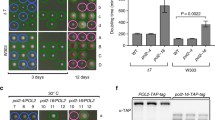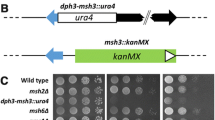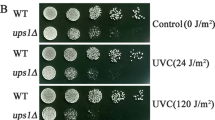Summary
The effects of the acridines euflavine and proflavine on mitochondrial DNA (mtDNA) replication and mutation inSaccharomyces cerevisiae have been compared. In contrast to previous results we found that under our conditions proflavine can indeed induce high levels (>80%) of petite mutants, although six times less efficiently than euflavine. The parameters measured for mutagenesis of the mitochondrial genome and inhibition of mtDNA replication in whole cells suggest that the modes of action of euflavine and proflavine are very similar. After extended (18h) treatment of growing cells with each drug the percentage loss of mtDNA or genetic loci was almost coincidental with the extent of petite induction.
It was found that proflavine is equally as effective as euflavine in inhibiting mtDNA replication in isolated mitochondria in contrast to the differential between the drugs observed in vivo. However, proflavine and euflavine inhibit cellular growth at almost the same concentrations. It is therefore proposed that there is some intracellular permeability barrier which impedes proflavine access to the mitochondrial DNA replicating system.
The petites induced by euflavine (and proflavine) are characterized by there being a preferential induction ofrho 0 petites lacking mtDNA as opposed torho - petites retaining mtDNA. This is in contrast to the relative proportions of such petites induced by ethidium bromide or berenil. A scheme for the production of petites by euflavine is presented, in which euflavine inhibits the replication of mtDNA, but does not cause direct fragmentation of mtDNA (unlike ethidium bromide and berenil). The proposed scheme explains the production of the high frequency ofrho o cells, as well as therho - cells induced by euflavine. The scheme also accounts for previous observations that euflavine only mutants growing cultures, and that the buds, but not mother cells, become petite.
Similar content being viewed by others
References
Albert, A., Rubbo, S.D., Goldacre, R.J., Davey, M.E., Stone, J.D.: The influence of chemical constitution on antibacterial activity. II. A general survey of the acridine series. Brit. J. exp. Path.26, 160–192 (1945)
Avers, C.J., Rancourt, M.W., Lin, F.H.: Intracellular mitochondrial diversity in various strains ofSaccharomyces cerevisiae. Proc. nat. Acad. Sci. (Wash.)54, 527–534 (1965)
Bastos, R.N., Mahler, H.R.: Molecular mechanisms of mitochondrial genetic activity. Effects of ethidium bromide on the deoxyribonucleic acid and energetics of isolated mitochondria. J. biol. Chem.249, 6617–6627 (1974)
Bernardi, G., Prunell, A., Fonty, G., Kopecka, H., Strauss, F.: The mitochondrial genome of yeast: organisation, evolution and the petite mutation. In: The genetic function of mitochondrial DNA (Saccone, C. and Kroon, A.M., eds.), pp. 185–198. Amsterdam: North Holland Publishing Co. 1976
Clark-Walker, G.D., Miklos, G.L.G.: Mitochondrial genetics, circular DNA and the mechanism of the petite mutation. Genet. Res. (Camb.)24, 43–57 (1974)
Cobon, G.S., Crowfoot, P.D., Linnane, A.W.: Biogenesis of mitochondria. 35. Phospholipid synthesis by yeast mitochondrial and microsomal fractions. Biochem. J.194, 265–275 (1974)
Ephrussi, B.: Nucleocytoplasmic relations in micro-organisms. Oxford: Clarendon Press 1953
Ephrussi, B., Hottinguer, H.: Direct demonstration of the mutagenic activity of euflavine on baker's yeast. Nature (Lond.)166, 956–958 (1950)
Gillham, N. W.: Genetic analysis of the chloroplast and mitochondrial genomes. Ann. Rev. Genet.8, 347–391 (1974)
Goldring, E.S., Grossman, L.I., Krupnick, D., Cryer, D.R., Marmur, J.: The petite mutation in yeast. I. The loss of mitochondrial DNA during petite induction with ethidium bromide. J. molec. Biol.52, 323–335 (1970)
Hall, R.M., Mattick, J.S., Marzuki, S., Linnane, A.W.: Evidence for a functional association of DNA synthesis with the membrane in mitochondria ofSaccharomyces cerevisiae. Molec. Biol. Reports2, 101–106 (1975)
Hall, R.M., Nagley, P., Linnane, A.W.: Biogenesis of mitochondria. 42. Genetic analysis of the control of mitochondrial DNA levels inSaccharomyces cerevisiae. Molec. gen. Genet.145, 169–175 (1976)
Kroon, A. M., de Vries, H.: Mitochondriogenesis in animal cells: studies with different inhibitors. In: Autonomy and biogenesis of mitochondria and chloroplasts (Boardman, N. K., Linnane, A. W. and Smillie, R. M., eds.), pp. 318–327. Amsterdam: North Holland Publishing Co. 1971
Lerman, L.S.: The structure of the DNA-acridine complex. Proc. nat. Acad. Sci. (Wash.)49, 94–102 (1963)
Linnane, A.W., Haslam, J.M., Lukins, H.B., Nagley, P.: The biogenesis of mitochondria in microorganisms. Ann. Rev. Microbiol.26, 163–198 (1972)
Mahler, H.R.: Genetic autonomy of mitochondrial DNA. In: Molecular cytogenetics (Hamkalo, B. and Papaconstantinou, J., eds.), pp. 181–208. New York: Plenum Press 1973a
Mahler, H.R.: Structural requirements for mitochondrial mutagenesis. J. supramol. Struct.1, 449–460 (1973b)
Mahler, H.R., Bastos, R.N.: Coupling between mitochondrial mutation and energy transduction. Proc. nat. Acad. Sci. (Wash.)71, 2241–2245 (1974)
Mahler, H.R., Perlman, P.S.: Induction of respiratory deficient mutants inSaccharomyces cerevisiae by berenil. I. Berenil, a novel, non-intercalating mutagen. Molec. gen. Genet.121, 285–294 (1973)
Marcovich, H.: Action de l'acriflavine sur les levures. VIII. Determination du component actif et étude de l'euflavine. Ann. Inst. Pasteur (Paris)81, 452–468 (1951)
Marcovich, H.: Rapports entre la structure des acridines et leur activité en tant qu'agents inducteurs de mutants respiratoires chez la levure. Ann. Inst. Pasteur (Paris)85, 199–216 (1953a)
Marcovich, H.: Influence de pH sur l'action toxique et mutagene de l'euflavine sur les levures. Ann. Inst. Pasteur (Paris)85, 443–450 (1953b)
Mattick, J.S., Hall, R.M.: Replicative DNA synthesis in isolated mitochondria ofSaccharomyces cerevisiae. J. Bact. (in press, 1977)
Michaelis, G., Douglass, S., Tsai, M., Criddle, R.S.: Mitochondrial DNA and suppressiveness in petite mutants inSaccharomyces cerevisiae. Biochem. Genet.5, 487–495 (1971)
Nagai, S.: Induction of the respiratory-deficient mutation in yeast by various synthetic dyes. Science (N.Y.)130, 1188–1189 (1959)
Nagley, P., Gingold, E.B., Lukins, H.B., Linnane, A.W.: Biogenesis of mitochondria. XXV. Studies on the mitochondrial genomes of petite mutants of yeast using ethidium bromide as a probe. J. molec. Biol.78, 335–350 (1973)
Nagley, P., Linnane, A.W.: Mitochondrial DNA deficient petite mutants of yeast. Biochem. biophys. Res. Commun.39, 989–996 (1970)
Nagley, P., Linnane, A. W.: Biogenesis of mitochondria. XXI. Studies on the nature of the mitochondrial genome in yeast: the degenerative effects of ethidium bromide on mitochondrial genetic information in a respiratory competent strain. J. molec. Biol.66, 181–193 (1972)
Nagley, P., Mattick, J.S.: Mitochondrial DNA replication in petite mutants of yeast: resistance to inhibition by ethidium bromide, berenil and euflavine. Molec. gen. Genet.152, 277–283 (1977)
Nagley, P., Mattick, J.S., Hall, R.M., Linnane, A.W.: Biogenesis of mitochondria. 43. A comparative study of petite induction and inhibition of mitochondrial DNA replication by ethidium bromide and berenil. Molec. gen. Genet.141, 291–304 (1975)
Mass, M.M.K.: Differential effects of ethidium bromide on mitochondrial and nuclear DNA synthesis in vivo in cultured mammalian cells. Exp. Cell Res.72, 211–222 (1972)
Perlman, P.S., Mahler, H.R.: Molecular consequences of ethidium bromide mutagenesis. Nature (Lond.) New Biol.231, 12–16 (1971)
Prunell, A., Bernardi, G.: The mitochondrial genome of wild type yeast cells. IV. Genes and Spacers. J. molec. Biol.86, 825–842 (1974)
Roth, J.R.: Frameshift mutations. Ann. Rev. Genet.8, 319–346 (1974)
Saunders, G.W., Gingold, E.B., Trembath, M.K., Lukins, H.B., Linnane, A.W.: Mitochondrial genetics in yeast: segregation of a cytoplasmic determinant in crosses and its loss or retention in the petite. In: Autonomy and biogenesis of mitochondria and chloroplasts (Boardman, N.K., Linnane, A.W. and Smillie, R.M., eds.), pp. 185–193. Amsterdam: North Holland Publishing Co. 1971
Slonimski, P.P.: A specific relation between enzymic adaptation and cytoplasmic mutation. Symp. Soc. gen. Microbiol.3, 76–94 (1953)
Slonimski, P.P., Perrodin, G., Croft, J.H.: Ethidium bromide induced mutation of yeast mitochondria: complete transformation of cells into respiratory deficient non-chromosomal “petites”. Biochem. biophys. Res. Commun.30, 232–239 (1968)
Smith, C.A., Jordan, J.M., Vinograd, J.: In vivo effects of intercalating drugs on the superhelix density of mitochondrial DNA isolated from human and mouse cells in culture. J. molec. Biol.59, 255–272 (1971)
Tewari, K.K., Votsch, W., Mahler, H.R., Mackler, B.: Biochemical correlates of respiratory deficiency. VI. Mitochondrial DNA. J. molec. Biol.20, 453–481 (1966)
Wallace, P.G., Huang, M., Linnane, A.W.: The biogenesis of mitochondria. II. The influence of medium composition on the cytology of anaerobically grownSaccharomyces cerevisiae. J. Cell Biol.37, 207–220 (1968)
Waring, M.: Variation of the supercoils in closed circular DNA by binding of antibiotics and drugs: evidence for molecular models involving intercalation. J. molec. Biol.54, 247–279 (1970)
Williamson, D.H.: The effect of environmental and genetic factors on the replication of mitochondrial DNA in yeast. In: Control of organelle development (Miller, P.L., ed.), pp. 247–276. Cambridge: University Press 1970
Williamson, D.H., Fennell, D.J.: Apparent dispersive replication of yeast mitochondrial DNA as revealed by density labelling experiments. Molec. gen. Genet.131, 193–207 (1974)
Wintersberger, E.: Synthesis of DNA in isolated yeast mitochondria. In: Biochemical aspects of the biogenesis of mitochondria (Slater, E.C., Tager, J.M., Papa, S. and Quagliariello, E., eds.), pp. 189–201. Bari: Adriatica Editrice 1968
Author information
Authors and Affiliations
Additional information
Communicated by W. Gajewski
Rights and permissions
About this article
Cite this article
Mattick, J.S., Nagley, P. Comparative studies of the effects of acridines and other petite inducing drugs on the mitochondrial genome ofSaccharomyces cerevisiae . Molec. Gen. Genet. 152, 267–276 (1977). https://doi.org/10.1007/BF00693080
Received:
Issue Date:
DOI: https://doi.org/10.1007/BF00693080




